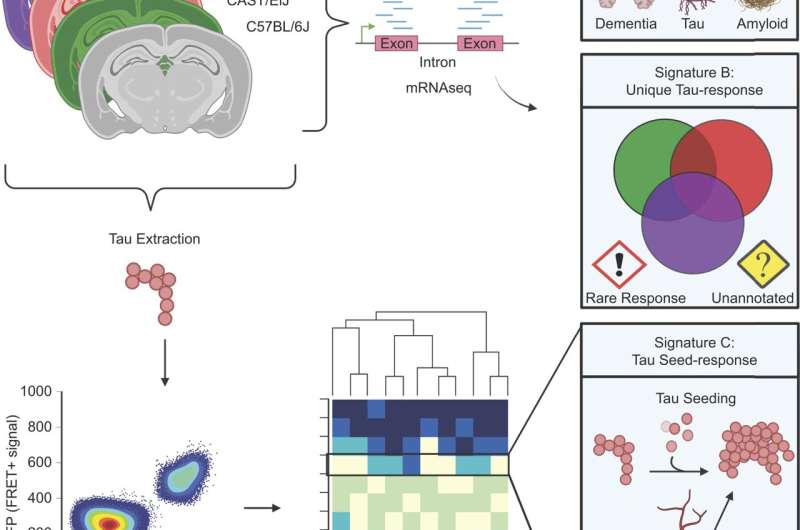This article has been reviewed according to Science X's editorial process and policies. Editors have highlighted the following attributes while ensuring the content's credibility:
fact-checked
peer-reviewed publication
trusted source
proofread
Neuroscientists create new resource to improve Alzheimer's disease research models

A new study by Indiana University School of Medicine researchers uses more genetically diverse mouse models to study the accumulation and spread of abnormal tau protein deposits in the brain—a known sign of Alzheimer's disease and several other neurodegenerative diseases. The study's findings, recently published in the Journal of Experimental Medicine, could lead to better research models that improve understanding of how different genetic backgrounds influence neurodegenerative disease development and treatment needs.
"As the medical community aims to treat those suffering from neurodegenerative diseases like Alzheimer's, it is critical for us to understand how the brain responds to these tau abnormalities," said Dominic J. Acri, first author on the study and a Ph.D. candidate at IU School of Medicine. "Genetically diverse animal models are an exciting new avenue to discover novel mechanisms of disease. This work is a foundational first step for genetic mapping studies that could reveal druggable targets for neurodegenerative diseases."
The research team was led by Jungsu Kim, Ph.D., the P. Michael Conneally Professor of Medical and Molecular Genetics and an investigator in the Stark Neurosciences Research Institute at IU School of Medicine.
Kim said the study was made successful in part by IU School of Medicine scientists' expertise in animal research models for Alzheimer's disease—one of many neuroscience strengths that make the school home to one of the world's most comprehensive Alzheimer's disease research programs, from basic science to drug discovery.
"I am grateful for the great collaborative environment that we have created at IU," Kim said. "It has allowed us to share ideas, learn from each other and work together on this project more efficiently. Without this type of collaborative support from the laboratories of Drs. Cristian Lasagna-Reeves, Stephanie Bissel, and Bruce Lamb, this project might have taken a few more years."
To date, most preclinical studies performed in mouse models of diseases utilize one inbred genetic background.
"This means that—unlike humans—every mouse in a given study is essentially a clone containing identical genetic information," Acri said. "We hypothesized that using genetically diverse mouse models may improve our ability to translate findings in mice to help patients suffering from neurodegenerative diseases."
This new study is unique, Acri said, because the research team used models of mice from three different genetic backgrounds, in addition to the single genetic background often presumed to be sufficient to model various human diseases.
Their findings suggest that these different genetic strains are an ideal resource for investigating the contribution of genetic variation to the study of Alzheimer's and other diseases caused by tau abnormalities.
The study also identified:
- A core tau-responsive transcriptional signature that is not affected by genetic background.
- A unique transcriptional response to tau that may indicate genetically diverse mice strains should be used to study certain risk genes.
- A tau seeding activity associated transcriptional signature that implicates microglia.
Because most therapeutic approaches are tested in mice before progressing to clinical trials, the researchers said including genetically diverse mice may enhance the translatability of these models to treating patients with different genetic backgrounds. They plan to further explore their findings in future studies to model the newly identified genes on genetically diverse mouse, zebrafish and fly models.
More information: Dominic J. Acri et al, Network analysis identifies strain-dependent response to tau and tau seeding-associated genes, Journal of Experimental Medicine (2023). DOI: 10.1084/jem.20230180




















